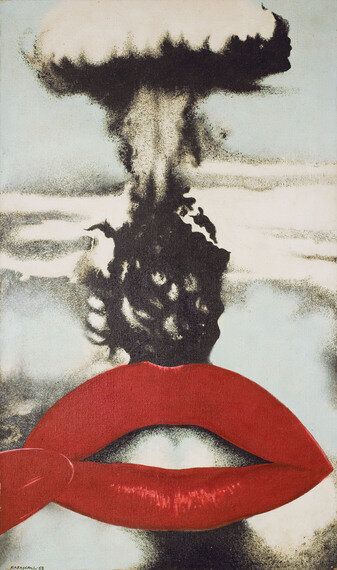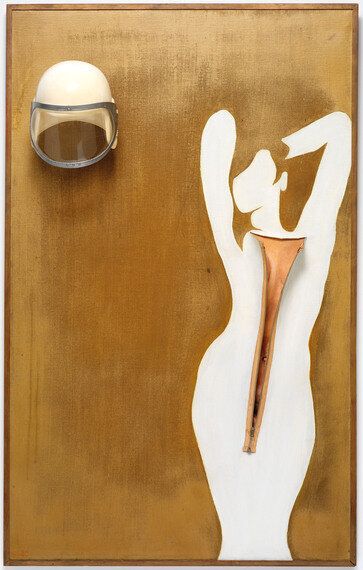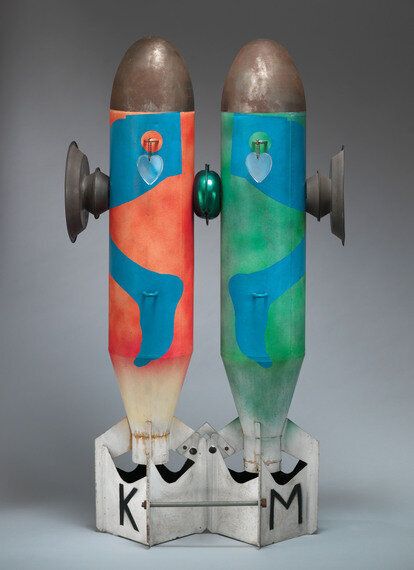
Like all good Pop art exhibitions, The World Goes Pop is loud, brash and full of colour. But this new show at the Tate Modern is not your typical collection of Warhols and Lichtensteins. Not at all. Instead the Tate is throwing out conventional perceptions of Pop art as an Anglo-American phenomenon and is instead bringing into focus Pop art work from around the world - from Latin America to Asia, from Europe to the Middle East.
How did these artists respond to an art movement that seemed so focused on Western consumerism? And given that many of these countries were not even capitalist in the 1960s, how did they use Pop art to reflect on their own cultures? These are exciting questions and ones the Tate addresses with a wide variety of work displayed in a bold and punchy exhibition.
When you first enter, it's a little overwhelming. There's the noise - many of the exhibits incorporate media. And there are the colours - each wall has been repainted in a bright hue of red, green or blue. And then there's the space. These aren't sedate paintings hung quietly on a wall but art works that invade your space and take over the room.
It takes more than a moment to adjust - but once you do you will discover there are powerful messages wrapped up in these pieces.

American Pop art often focused on advertising and iconic celebrities. But this was also a time when America was at War - either explicitly in Vietnam, or in a stand-off with the Russians. It's interesting then that many of the non-US artists looked to take this movement's artistic focus on consumerism and contrast this with the violence in the world.
Atomic Kiss, 1968, by Joan Rabascall shows an iconic pair of red lip plastered over an image of an atomic explosion. Whereas Bernard Rancillac's At Last, A Silhouette Slimmed to the Waist, 1966, takes a picture of American troops torturing a Viet Cong soldier and frames it with cut-outs of advertisements for corsets.
Often that political commentary was turned inwards, such as in Equipo Cronica's Concentration or Quantity Becomes Quality, 1966, which looks at mass gatherings in Franco's Spain and how individual acts of protest can solidify into effective collective resistance.

The era of Pop art was also a time for women's liberation and the Tate has included many pieces from female artists who explored the politics and representation of the female form.
Jana Zelibska's immersive work Kandarya-Mahadeva, 1969, takes over one of the galleries. Around the room are large and small outlines of the naked female form. Yet the gaze of voyeurs is challenged by placing mirrors strategically around the female body, on those parts where the gaze may linger a little longer.
Another of her pieces, Breasts, 1967, looks at the eroticism of the female body by taking two representations of breasts and placing one of them behind a net curtain. By this simple act alone, the female body becomes tempting and tantalising despite the fact that the object itself has not changed.
Gender identity itself is looked at in Renate Bertlmann's Exhibitionism, 1973, where the outlines and contours of a female form are juxtaposed with egg-shaped objects, representing male genitals.

What really intrigues though is not just how these artists used Pop art to interrogate their own cultures, but how they also responded to the Pop art headliners from the US and the UK.
The stand-out piece in that regard has to be Cuba's Raul Martinez's Oye America! (Listen America!), 1967. Warhol has his endless repeated images of Marilyn. Here Raul uses the same trick - only this time with a state-approved image of Fidel Castro.
Another series of pictures that impressed were Erro's American Interiors, 1968. The desirability of the American home was a subject addressed by many American Pop artists. Here, Erro has the peaceful, idealised American home being invaded by Viet Cong and Maoist troops.
The Tate Modern has brought together an impressive range of art for this exhibition, and amount too. 160 works in total fill these galleries, and many have never been seen in the UK before. One particular piece, Henri Cueco's Large Protest, 1969, has not been seen anywhere since 1970.
Large Protest was part of a body of work Henri made in response to the May 1968 protests in France, Vietnam and the Cold War. In many ways this one piece sums up the spirit of this whole exhibition - life-size cut-out figures drawn in comic book-style jut out into the room. Many of these figures are suspended just above the floor, making them slightly surreal. Yet in the centre of the group, one of these dream-like figures is punching her fist directly into the air. That spirit of revolution and resistance never far from the surface.
Tate Modern, London to January 24, 2016
Image Credits:
1.Doll Festival 1966 Fluorescent paint, oil, plastic board on plywood. Hyogo Prefectural Museum of Art (Yamamura Collection) © Ushio and Noriko Shinohara
2.Joan Rabascall Atomic Kiss 1968 Acrylic on canvas 1620 x 970 mm. MACBA Collection. Barcelona City Council Fund. Photo: Tony Coll © ADAGP, Paris and DACS, London 2015
3.Evelyne Axell Valentine 1966 Collection of Philippe Axell. Photo: Paul Louis © Evelyne Axell/DACS 2015
4.Kiki Kogelnik Bombs in Love 1962 Kevin Ryan/Kiki Kogelnik Foundation Vienna/New York.